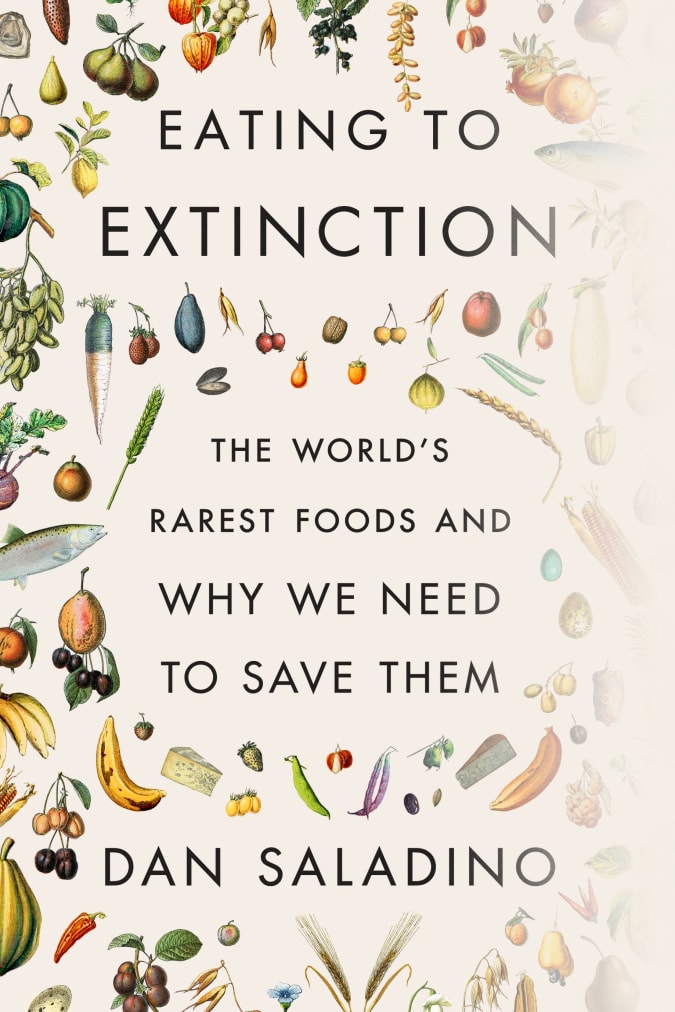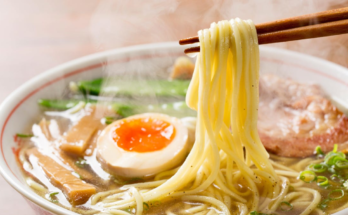Feeding the planet’s 8 billion people is challenge enough and our current industrialized commercial practices are causing such ecological damage that we may soon find ourselves hard-pressed to feed any more. For decades, scientists have sought out higher yields and faster growth at the expense of genetic diversity and disease — just look at what we’ve done to the humble banana. Now, finally, researchers are working to revitalize landrace and heirloom crop varieties, using their unique, and largely forgotten, genetic diversity to reimagine global agriculture.
In his new book, Eating to Extinction: The World’s Rarest Foods and Why We Need to Save Them, BBC food journalist Dan Saladino scours the planet in search of animals, vegetables and legumes most at-risk of extinction, documenting their origins and declines, as well as the efforts being made to preserve and restore them. In the excerpt below, Saladino takes a look at all-important rice, the cereal that serves as a staple crop for more than 3.5 billion people around the world.

Farrar, Straus and Giroux publishing
Excerpted from Eating to Extinction: The World’s Rarest Foods and Why We Need to Save Them by Dan Saladino. Published by Farrar, Straus and Giroux. Copyright © 2021 by Dan Saladino. All rights reserved.
Whereas the global Green Revolution was largely steered by American science and finance, China’s push for greater food production was more self-contained. Both efforts happened more or less in parallel. Mao’s attempt at rapid industrialization, the ‘Great Leap Forward’ in the late 1950s, forced farmers off their land, leading to famine and the death of millions. Soon after, an agricultural researcher, Yuan Longping, was given the task of helping China’s recovery by increasing the supply of rice. Based in a lab in Hunan, Yuan, like Borlaug in Mexico, spent years working with landraces and crossing varieties in meticulous experiments. By the early 1970s, he had developed Nan-you No. 2, a hybrid rice so productive it had the potential to increase food supply by nearly a third. Farmers were told to replace the old varieties with the new, and by the start of the 1980s, more than 50 per cent of China’s rice came from this single variety. But, as with Borlaug’s wheat, Yuan’s rice depended on huge amounts of fertilizers, pesticides and lots and lots of water.
In the 1960s, in another part of Asia, a team of scientists were also breeding new rice varieties. What became known as the International Rice Research Institute (IRRI) in the Philippines was funded by the American Rockefeller and Ford Foundations. The IRRI’s plant breeders also made a breakthrough drawing on the genetics of a dwarf plant. This new pest-resistant, high-yielding rice, called IR8, was released across India, Pakistan and Bangladesh in 1966. Using the Green Revolution package of irrigation, fertilizers and pesticides, IR8 tripled yields and became known as ‘miracle rice’. As it rapidly spread across Asia (with the necessary agrichemicals subsidized by Western foundations and governments), farmers were encouraged to abandon their landrace varieties and help share the new seeds with neighbors and relatives in other villages. Social occasions, including weddings, were treated by Western strategists as opportunities to distribute IR8. A decade later, rice scientist Gurdev Khush, the son of an Indian rice farmer, improved on the ‘miracle rice’ (IR8 wasn’t the tastiest rice to eat and had a chalky texture). A later iteration, IR64, was so productive that it became the most widely cultivated rice variety in the world. But while most of the world was applauding the increase in calories created by the new rice varieties, some people were sounding a note of caution about what was also being lost.
In July 1972, with the Green Revolution in full flow, the botanist Jack Harlan published an article entitled ‘The Genetics of Disaster’. As the world’s population was increasing faster than at any time in history, Harlan said, crop diversity was being eroded at an equally unprecedented rate. ‘These resources stand between us and catastrophic starvation on a scale we cannot imagine,’ he argued. ‘In a very real sense, the future of the human race rides on these materials.’ Bad things can happen at the hands of nature, Harlan reminded his readers, citing the Irish potato famine. ‘We can survive if a forest or shade tree is destroyed, but who would survive if wheat, rice, or maize were to be destroyed? We are taking risks we need not and should not take.’ The solutions being developed in the Green Revolution would be as good as they could be until they failed – and when they did, the human race would be left facing disaster, he warned. ‘Few will criticize Dr. Borlaug for doing his job too well. The enormous increase in . . . yields is a welcome relief and his achievements are deservedly recognized, but if we fail to salvage at least what is left of the landrace populations of Asia before they are replaced, we can justifiably be condemned by future generations for squandering our heritage and theirs.’ We were moving from genetic erosion, he said, to genetic wipe-out. ‘The line between abundance and disaster is becoming thinner and thinner, and the public is unaware and unconcerned. Must we wait for disaster to be real before we are heard? Will people listen only after it is too late?’ It may be nearly too late, but, fifty years on, people are listening to Harlan.
One of them is Susan McCouch, Professor of Plant Breeding and Genetics at Cornell University and an expert on rice genetics. Her research includes the less familiar aus rice which evolved in the Bangladeshi delta. ‘It has the most stress-tolerant genes of all the rice we know,’ says McCouch. ‘It grows on poor soils, survives drought and is the fastest species to go from seed to grain.’ And yet aus is endangered. Most farmers in Bangladesh have abandoned it and switched to more commercial varieties. Only the poorest people have saved the rice, farmers who couldn’t afford to buy fertilizers and build irrigation systems. Its genetics are so rare because, unlike japonica and indica which travelled far and wide, aus stayed put. ‘The people who domesticated it never left the river delta,’ says McCouch. ‘They weren’t empire builders, didn’t have armies and never enslaved populations.’ But by bequeathing the world aus, they have left their mark.
In 2018, McCouch, along with researchers from USDA, released a new rice called Scarlett. It was, the team said, a rice with nutty rich flavors but also ‘packed with high levels of antioxidants and flavonoids along with vitamin E’. To create it, McCouch had crossed an American long-grain rice called Jefferson and a rice that was discovered in Malaysia. The reason the new rice was packed with nutrients and called Scarlett was because the Malaysian plant was a red-colored wild species. One person who would have been unsurprised at the special qualities of these colored grains was Sun Wenxiang, the farmer I had visited in Sichuan.
Inside a room on his farm, Sun was packing up small parcels of his special red rice to send to customers in Beijing, Shanghai, Chengdu and Hangzhou. They order his red mouth rice on WeChat, the Chinese social media app used by more than a billion people across Asia that is part Twitter and part PayPal (and so much more). Some have told him they buy it for its taste or intriguing color, but most buy it for its health properties.
For farmers such as Sun working to save China’s endangered foods, help is at hand at the Centre for Rural Reconstruction, a modern day iteration of a movement founded a century ago to empower peasants and revitalize villages. In the 1920s a group of intellectuals and smallholders set up the original Rural Reconstruction Movement to develop farms, improve crops, establish co-operatives and sell more produce in China’s towns and cities. After the revolution, and during Mao’s rule, it disappeared, but in the 1990s was resurrected. A former government economist named Professor Wen Tiejun believed rural communities across China faced serious decline as manufacturing boomed and millions of people migrated from thousands of villages. By 2010, the country had experienced the largest and most rapid rural-to-urban migration ever witnessed in human history. Professor Wen began to ask what this meant for the future of China’s small-scale farmers and the food they produced and, as a result, he launched the New Rural Reconstruction Movement.
The garden surrounding the two-story training center 50 miles north of Beijing is a statement of intent: its raised beds are fertilized with night soil, the nutrients processed from a row of eco-toilets (an ancient technique, as Chinese farmers enriched their fields using human and animal waste for thousands of years). The idea came from a book written a century ago, not by a Chinese agricultural expert, but an American one. Farmers of Forty Centuries by Franklin Hiram King has become essential reading matter for some students at China’s Centre for Rural Reconstruction.
In the early 1900s, King, an agronomist from Wisconsin, worked at the United States Department of Agriculture, but he was regarded as a maverick, more interested in indigenous farming systems than the agricultural expansion the department had been set up to deliver. Convinced that he could learn more from peasant farmers than the scientists in Washington, King left the United States in 1909 and set out on an eight-month expedition through Asia. ‘I had long desired to stand face to face with Chinese and Japanese farmers,’ he wrote in the book’s introduction, ‘to walk through their fields and to learn by seeing some of their methods, appliances and practices which centuries of stress and experience have led these oldest farmers in the world to adopt.’ King died in 1911 before he had completed his book and the work was pretty much forgotten until 1927, when a London publisher, Jonathan Cape, discovered the manuscript and published it, ensuring it remained in print for the next twenty years. It went on to influence the founding figures in Britain’s organic movement, Albert Howard and Eve Balfour. The farmers who visit the Centre for Rural Reconstruction and come across King’s book, will read an account of how food was produced in China’s villages a century ago. Crops grown then, now endangered, are also being resurrected.
Inside a storeroom at the center, now a bank of some of China’s rarest foods, I was shown boxes full of seeds and jars and packets of ingredients all produced by farming projects in villages supported by the New Rural Reconstruction Movement. All were distinctive products that were helping to increase farmers’ incomes. There was dark green soy from Yunnan in the south; red-colored ears of wheat from the north; wild tea harvested from ancient forests; and bottles of honey-colored rice wine. And among other varieties of landrace rice was Sun Wenxiang’s red mouth glutinous grains.
‘When we lose a traditional food, a variety of rice or a fruit, we store up problems for the future,’ Professor Wen told me. ‘There’s no question China needs large-scale farms, but we also need diversity.’ With 20 per cent of the world’s population, China encapsulates the biggest food dilemmas of our times. Should it intensify farming to produce more calories, or diversify to help save the planet? In the long run, there is no option but to change the system. China suffers from wide-scale soil erosion, health-harming levels of pollution and water shortages. As a consequence, land has become contaminated, there are algae blooms around its coastline and high levels of greenhouse gas emissions.
There are signs of change. In September 2016 China ratified the Paris Agreement on Climate Change. Among the specific targets it set was zero growth in fertilizer and pesticide use. To conserve more of its genetic resources and crop diversity, China is one of the few countries investing heavily in new botanic gardens to protect and study endangered species. The Chinese Academy of Agricultural Sciences has also built a collection of half a million samples of landrace crops, varieties now being researched for future use. This is what Jack Harlan might have called the genetics of salvation. It’s a long way from King’s Farmers of Forty Centuries, but there is clear recognition that China’s current food system can’t go on as before.
‘We need to modernize and develop, but that doesn’t mean letting go of our past,’ said Wen. ‘The entire world should not be chasing one way of living, we can’t all eat the same kind of food, that is a crazy ideology.’ And then he shared the famous quote attributed to Napoleon: ‘Let China sleep, for when she wakes, she will shake the world.’ ‘Well,’ said Wen, ‘we have woken up and we’ve started to eat more like the rest of the world. We need to find better ways of living and farming. Maybe some answers can be found in our traditions.’
All products recommended by Engadget are selected by our editorial team, independent of our parent company. Some of our stories include affiliate links. If you buy something through one of these links, we may earn an affiliate commission.


